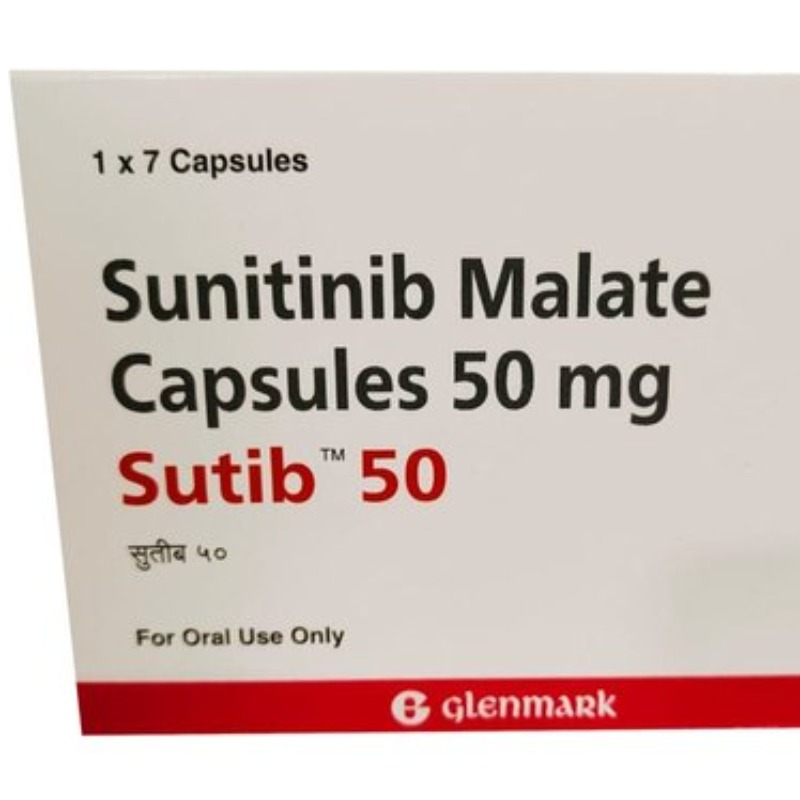DESCRIPTION
MECHANISM OF ACTION
• Inhibits multiple RTKs, some of which are involved in tumor growth, tumor angiogenesis, and metastasis.
• Potent inhibitor of platelet-derived growth factor receptors (PDGFR-α and PDGFR-β), vascular endothelial
growth factor receptors (VEGFR-1,
VEGFR-2, and VEGFR-3), stem cell factor receptor (Kit), Fms-like tyrosine kinase-3 (Flt3), colony-stimulating
factor receptor type 1 (CSF-1R), and the glial cell-line derived neurotrophic factor receptor (RET).
ABSORPTION
Oral bioavailability is nearly 100%. May be taken with or without food, as food does not affect oral bioavailability.
DISTRIBUTION
Extensive binding (90%–95%) of sunitinib and its primary metabolite to plasma proteins. Peak plasma levels are achieved 6 to 12 hours after ingestion.
Steady-state drug concentrations of sunitinib and its primary active metabolite are reached in 10 to 14 days.
INDICATIONS
1. FDA-approved for GIST after disease progression on or intolerance to imatinib.
2. FDA-approved for advanced renal cell cancer (RCC).
3. FDA-approved for the adjuvant treatment of patients at high risk of recurrent RCC following nephrectomy.
4. FDA-approved for progressive, well-differentiated PNET in patients with unresectable locally advanced or metastatic disease.
DOSAGE RANGE
1. GIST and RCC: 50 mg/day PO for 4 weeks followed by 2 weeks off.
2. GIST and RCC: An alternative schedule is 50 mg/day PO for 2 weeks followed by 1 week off.
3. Adjuvant therapy of RCC: 50 mg/day PO for 4 weeks followed by 2 weeks off for nine 6-week cycles.
4. PNET: 37.5 mg/day PO continuously.
5. RCC: Alternative schedule is 37.5 mg/day PO continuously for first- and second-line treatment
DRUG INTERACTION 1
Drugs such as ketoconazole, itraconazole, erythromycin, clarithromycin, atazanavir, indinavir, nefazodone, nelfinavir, ritonavir, saquinavir, telithromycin, and voriconazole decrease the rate of metabolism of sunitinib, resulting in increased drug levels and potentially increased toxicity.
DRUG INTERACTION 2
Drugs such as rifampin, phenytoin, phenobarbital, carbamazepine, and
St. John’s Wort increase the rate of metabolism of sunitinib, resulting in its inactivation and reduced drug levels.
SPECIAL CONSIDERATIONS
1. Baseline and periodic evaluations of LVEF should be performed while on sunitinib therapy.
2. Use with caution in patients with underlying cardiac disease, especially those who presented with cardiac events within 12 months prior to initiation of sunitinib, such as MI (including severe/unstable angina), coronary/peripheral artery bypass graft, and CHF.
3. In the presence of clinical manifestations of CHF, discontinuation of sunitinib is recommended. The dose of sunitinib should be interrupted and/or reduced in patients without clinical evidence of CHF but with an ejection fraction < 50% and > 20% below pretreatment baseline.
4. Closely monitor blood pressure while on therapy and treat as needed with standard oral antihypertensive medication. In cases of severe hypertension, temporary suspension of sunitinib is recommended until hypertension is controlled.
5. Closely monitor LFTs at baseline and during each cycle of therapy. Treatment should be interrupted for > grade 3 hepatotoxicity and should be stopped if there is no improvement in LFTs and/or there is evidence of liver failure.
6. No dose adjustment is necessary in patients with Child-Pugh Class A and B liver dysfunction. Sunitinib has not been studied in patients with Child-Pugh Class C liver disease, and caution should be used in this setting.
7. No dose adjustments are necessary in patients with mild, moderate, or severe renal dysfunction and in patients undergoing dialysis.
8. Monitor for adrenal insufficiency in patients who experience increased stress such as surgery, trauma, or severe infection.
9. Closely monitor thyroid function tests and TSH at 2- to 3-month intervals, as sunitinib treatment results in hypothyroidism. The incidence of hypothyroidism is increased with prolonged duration of therapy.
10. Avoid Seville oranges, starfruit, pomelos, grapefruit, and grapefruit products while on sunitinib therapy.
11. Pregnancy category D. Breastfeeding should be avoided.
TOXICITY 1
Hypertension occurs in up to nearly 30% of patients. Usually occurs within 3–4 weeks of starting therapy and is well controlled with oral antihypertensive medication.
TOXICITY 2
Yellowish discoloration of the skin occurs in approximately 30% of patients. Skin rash, dryness, thickness, and/or cracking of skin. Depigmentation of hair and/or skin may also occur.
TOXICITY 3
Bleeding complications, with epistaxis most commonly observed.
TOXICITY 4
Hepatotoxicity with elevated LFTs and serum bilirubin. In severe cases, liver failure or death can occur.
TOXICITY 5
Constitutional side effects with fatigue and asthenia, which may be significant in some patients.
TOXICITY 6
Diarrhea, stomatitis, altered taste, and abdominal pain are the most common GI side effects. Pancreatitis has been reported rarely with elevations in serum lipase and amylase.
TOXICITY 7
Myelosuppression with neutropenia and thrombocytopenia.
TOXICITY 8
Increased risk of left ventricular dysfunction, which in some cases results in CHF.
TOXICITY 9
Adrenal insufficiency and hypothyroidism.
TOXICITY 10
TTP, HUS, and thrombotic microangiopathy.
TOXICITY 11
Tumor lysis syndrome is a rare event that occurs in the setting of high tumor burden.
SPECIFICATION


Login To Comment